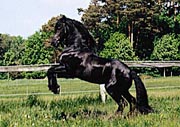Friesian
N/A
Tue, 26th November, 2024 - 10:21 pm GMT
Sponsor Ads:

Alternative Name
N/ABasic Info
Friesian Horses are always black. White markings are not allowed on the body or legs. They have a long, thick, flowing mane and tail and pronounced fetlock hair. Under no circumstance is it permissible to dock the tail of a Friesian and, in fact, trimming of any hair from mane, tail or legs is frowned upon. The Friesian Horse holds it head high and proud with an arching neck. The animated gait is natural. Selective breeding is used to achieve the active hock action and high, extended from leg action. The body is strong and deep with a sloping shoulder. The rear quarters are sloping with a somewhat low-set tail. Registered Friesian stallions must be at least 15.3 hands by the age of four and mares must be at least 14.3 hands. The mares average about 1300 lbs., more for males.
Health
N/AHabitat
N/ABehavior
Has a pleasant temperamentOrigin
FrieslandHistory
The Friesian Horse originated in Friesland, one of twelve provinces of the Kingdom of the Netherlands (Holland), situated in the northwest of Europe. Friesland is an old country dating to 500 B.C., when the Friesians settled along the cost of the North Sea. They were tradesmen, seafarers, farmers and horse breeders. The Friesian horse descends from the Equus robustus. During the 16th and 17th centuries, but probably also earlier, Arabian blood was introduced, especially through Andalusian horses from Spain. This has given them the high knee-action, the small head and the craning neck. Because of his temperament the Friesian horse is considered warm blooded. The Friesian horse has been kept free from influence of the English Thoroughbred. During the last two centuries it has been bred pure. Breeding horses and dealing in them was very important for the Friesians. The monks in the many monasteries in Friesland before the reformation did a lot of horse breeding. Through the centuries the Friesian Government has made many regulations in order to safeguard good breeding. Now the Dutch Horselaw of 1939 (modified) gives rules for studbook and breeding. From records of the past we know that the Friesian horse of old was famous. There is information from as early as 1251 and there are books in which Friesian horses were mentioned and praised from as early as the 16th century. The well-known English writer on horses, Anthony Dent, and others are of the opinion that the Friesian horse influenced the Old English Black Horse and the Fell Pony. Dent proposes that the Norwegian Døle (Gudbrandsdal horse), which shows great likeness to the Friesian horse, must have got there from Friesland either as booty or by regular trade. The Northern Swedish horse was greatly influenced by the Norwegian Døle. Dent also suggests a Norwegian influence on the English Dale pony. In the Pyrenees in southern France there is a pony "Ariege called after Merens" (Ariege dit de Merens) that looks remarkably like a small Friesian horse. The resemblance of the types mentioned can be traced back in some cases to the influence of Friesian horses, in other cases the similar way of breeding will have caused the similarity. As early as 1625 Friesian horses were being imported into what later would become the United States of America. The Dutch founded New Amsterdam in the region they discovered in 1609, but they had to abandon it to the English in 1664, when the name was changed to New York. Advertisements in the papers offer trotters of "Dutch" descent. These must have been Friesian horses. The able writer Jeanne Mellin proposes in her books The Morgan Horse (1961) and The Morgan Horse Handbook (1973) the possibility that this well-known American horse is of Friesian descent. The ability to trot fast, the heavy manes, the long rich tail and the fetlocks at the feet of the original forefather of this breed may be an indication. The breed was totally lost in North America due to crossbreeding. Tom Hannon of Canton, Ohio did not reintroduce the horse to North America until 1974. By 1983 the popularity of the Friesian in America had grown enough to support a national association and a national show. With the help of the Friesian Studbook Friesian horses have been imported into Western Germany, Scotland and South Africa (1957-58). The imports into South Africa occurred to improve the type of horse called the Flemish Horse, imported long ago from Belgium. Nowadays this type of horse is not found in Belgium anymore, except when imported from Friesland. *Adapted from the Summary in English which is part of the Dutch book titled "Het Friese Paard" by G. J. A. Bouma, 1979, and printed by Friese Pers Boekerij, b. v., in Drachten and Leeuwarden, The Netherlands. It is reproduced here with the kind permission of the Friesian Horse Association of North America, the author and Het Friesch Paarden-Stamboek.Common Foods
grassSponsor Ads:
"The hardest thing in the world to understand is the income tax." -- Albert Einstein
Friesian
Coded by: BGID® | ALL RIGHTS RESERVED Copyright © 2000-2024
Disclaimer | Privacy | Report Errors / Contact | Credits
















